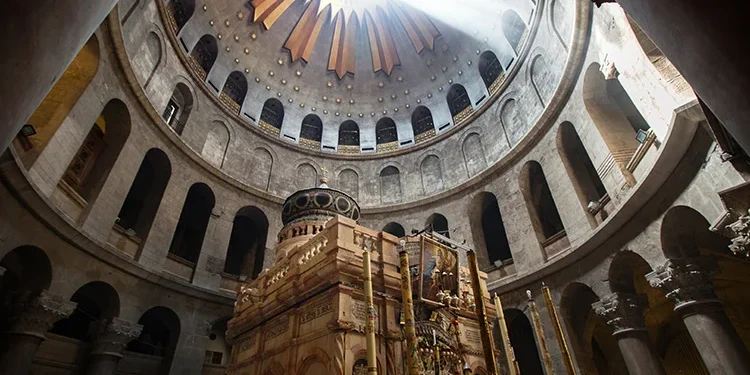
Israel, Family History, and Evangelical Snobbery
Evangelicals have a strange relationship with Israel. Now, far be it for me to get into geopolitics surrounding the modern nation state or dispensational eschatology. When it comes to the former, I am decidedly undecided, and when it comes to the latter, I am decidedly non-dispensational. The strange relationship evangelicals have with Israel I mean to describe is not directly concerned with these two loci of interests, though it may impact them. I’m concerned with something more subterranean and harder to define. It’s a vibe.
You see, evangelicals love Israel. They love to travel to Israel and to see all the sights. I myself had the privilege of traveling to Israel this past November and was eager to soak in all the major locations. I was just as enthused as anyone else in my tour group to sail out onto the sea of Galilee, and to visit Joppa and the location of Simon the Tanner’s home, and to float in the dead sea and try to avoid the burning that results from a tiny droplet in the eye, and to stand on the mount of beatitudes, and in the garden of Gethsemane, and to ascend Mount Zion, where Solomon’s temple once stood (and then Zerubbabel’s temple, and then Herod’s temple), the mound of which now soberly holds the Dome of the Rock. I loved every minute of my time in Israel (except when my wallet was stolen in Tiberius, but that’s a story for another time). And yet, the strange evangelical vibe I attempt to put my finger on here was indelibly present. It wasn’t so much exacerbated by our tour group as it was foisted upon us, when our tour guide would say things like, “Never mind that building, it’s just a Crusader-era building.”
Now, I’m not so much convinced that our tour guide himself had a prejudice against Crusader-era buildings as I am that he had been conditioned by certain expectations before we even arrived in his country. He had become aware of the fact that evangelicals, in general, are not interested in any historical artifact in Israel younger than the 1st century. I can’t blame him for forming this opinion about us evangelicals—it’s mostly accurate. No doubt his was a well-informed stereotype, reinforced by every evangelical’s discontented visit to the Church of the Holy Sepulcher.
All one must do to realize that evangelicals have a deep prejudice against any Christian-Israeli history between the 1st century and 1948 is compare the look of disappointment on the evangelical face at the Church of the Holy Sepulcher to the look of pure delight on the same face at the Garden Tomb. It does not matter to the evangelical enraptured by the Garden Tomb that it obviously is not the true location of Christ’s burial, and that the Church of the Holy Sepulcher actually does encompass the location of both Christ’s crucifixion and his burial and resurrection. You can point out that the earliest Christians had every reason to consecrate such a space as sacred (which they did). And you can point out how emperor Hadrian was more motivated to get the location right than anyone else when he demolished the area and built a temple to the goddess Venus in its place around the year of our Lord, 135. You can point out how most Christians recognize that this was a providential subversion—God used Hadrian’s attempt to blot out Christianity in order to forever safeguard the historical location of the event upon which human history hinges. Most Christians, that is, but not contemporary evangelicals. These points are outweighed by the deep evangelical prejudice against anything remotely “Catholic.” The Garden Tomb, after all, is a first century tomb, and it is much easier to imagine the body of Christ lying there than in the Church of the Holy Sepulcher—with its layers of centuries of Church history stacked on top of each other like paper mâché.
Evangelicals who visit Israel are often frustrated that Christians of the past did not show their respect for history the same way that we do. The way we show respect for history, of course, is to preserve and protect artifacts—we determine that the artifacts and locations we discover shall never be used again for any purpose. Any kind of interaction with the artifacts outside of careful, scientific observations will contaminate the findings, and are therefore anathema. Of course, I see the merit of this kind of approach to historical objects, and I am grateful for the careful preservation that archeologists have dedicated their lives to. But it is anachronistic to conclude that this is the only way to properly respect the past. Christians of yesteryear respected the past differently because they viewed the past differently. Rather than preserving the location of Hadrian’s temple on account of the Christian rubble underneath, Constantine built a church there. And then, after various battles and damage done to the building, the Crusaders rebuilt and expanded that church.
In doing so, they were not desecrating history, they were consecrating it. They viewed themselves as living in the same stream as the Christians who marked that space off as significant in the first century, and, indeed, downstream of the Christ who died and rose again there. The way they showed their devotion to the past was not to sterilize it and seal it off, but to use it for worship. The most respectful thing they thought they could do for the past was to bring the worship of the past into the present. Taken in this way, the august walls and mosaics and raised ceilings and icons and all the bricks laid on top of ancient bricks was not Medieval disregard for 1st century events, but rather expressions of devotion.
Most evangelicals who visit Israel lack this appreciation for Crusader-era church buildings precisely because of a particular kind of chronological snobbery. It’s not the kind that marks our progressive age, which views everything from the past as inferior. It’s rather a snobbishness towards any history after the time of Christ. Biblical history is the only history worth seeing. Again, please don’t get me wrong. Biblical history really is the most important history, and the archeological artifacts from the biblical timeline really are the most important archeological artifacts we can discover in Israel. But if we view the Christian tradition as a family heritage, we don’t have to be disappointed when an ancient cite doesn’t “look” ancient because of all the layers of Christian history stacked on top of it. Those layers are only held in place because of the foundation—each layer is a testimony to the importance of the biblical-historical foundation upon which it stands.
I loved my time in Israel, not despite all the “Catholic” post-apostolic buildings, but precisely because of them. They reminded me of the fact that I exist in a living tradition—I inhabit a house of the Lord, built upon the foundation of the apostles and prophets (Eph. 2:20). The Holy Spirit was not on a hiatus between the first century and now—Christ was, by his Spirit, building his Church throughout that time (Matt. 16:18). Every generation subsequent to his ascension until now has been marked by Christians passing down the faith once for all delivered to the saints (Jude 3). And in Christ, it’s all ours. All that history is our family history. We don’t have to look past the centuries of Church history covering the archeology of the biblical time, we can look through those centuries to the same Christ that transfixed the gaze of Christians living in each of those years. We ought not begrudge the historical mark they have left—the Christian story is theirs as much as it is ours.
Of course, all this brings up the sticky subject of ecumenicity. I have no intention of papering over such huge issues. At this point of my life, I am more decidedly Protestant than ever before—the more I learn about the distinctions between the major branches of the Christian faith, the more I am convinced that the Reformed Protestant tradition is the most faithful to Scripture, themost catholic, and the most respectful of the totality of Christian tradition. Further, the theological concerns that eventuated the Reformation in the 16th century have not gone away, and the purity of the gospel really is at stake. To put it starkly: I firmly believe that much of Roman Catholic and Orthodox theology today constitutes idolatry and a gross subversion of the gospel of Jesus Christ.
And yet… I cannot ignore the fact that such traditions and my own agree with theological statements as specific as the Apostle’s Creed, the Nicene Creed, and the Chalcedonian Definition. That common heritage is no small thing. So, while my protestations against their dogma cannot be more emphatic, I cannot deny they have a shared heritage. Jerusalem is part of their history just as it is ours. Which means, I feel no justification to scoff at all the smells and bells and icons and robes and mosaics and monasteries and church buildings scattered throughout the “Holy Land.” That is how they occupy their place in this massive, dysfunctional family history. I can acknowledge the legitimacy of their place in the land, and our shared Christian heritage, without minimizing the differences between us—differences that are quite literally matters of spiritual life and death. If we labor to rid ourselves of our chronological snobbery, we may even be able to embrace more of our shared heritage than the Bible alone—perhaps even up to and beyond the time of Crusader-era buildings.
Of course, the foregoing discussion is also a parable on biblicism and the need to respect the Great Tradition of Christianity. Let the reader understand.

